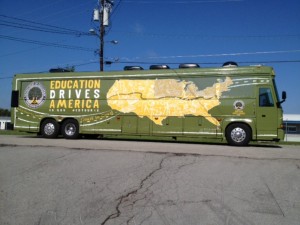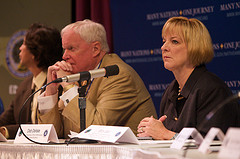WA School Leader Named National HS Principal of the Year
Trevor Greene helped rural, high-poverty school overcome the odds

Trevor Greene, principal of Toppenish High School in Toppenish, WA, has been named the 2013 MetLife/NASSP (National Association of Secondary School Principals) National High School Principal of the Year. The award was announced at a surprise assembly attended by students, teachers, district staff members, State Superintendent Randy Dorn, and representatives from the state legislature and Sen. Patty Murray’s office. Greene was honored during a black-tie gala on September 21 in Washington, DC, to kick off National Principals Month.
In transforming Toppenish High School into a high-performing place of learning, Trevor Greene brought a renewed sense of hope to rural Washington. Nestled on the Yakama Indian Reservation, Toppenish serves a high-minority (95%), high-poverty (100%) student population. Because he grew up on the reservation, Greene saw the consequences of generational poverty, and he made it his personal mission to return to the area and bring the community together to support students’ education.
Greene made parental engagement a priority, reaching out to migrant families and families from the Yakama Nation. A migrant advocate on-staff ensures that the needs of students from that special population are being met. Greene also brought in a graduation specialist who keeps students on track to graduate, and with the help of his staff, he spent the last four years directing resources to the students who need them most.
“Trevor Greene played a central role in helping Toppenish achieve significant and sustained improvement among students who are affected by poverty and its associated issues,” said NASSP Executive Director JoAnn Bartoletti. “Trevor’s relentless effort to increase rigor and provide opportunities for all students, regardless of socio-economic status, ensures a personalized learning environment where every student feels valued.”
Knowing the importance of establishing a culture of high expectations, Greene expanded academic opportunities for his students, many of whom had never been expected to succeed, let alone graduate. He added rigorous courses, including 27 high-profile engineering and biomedical classes, a Microsoft IT Academy class, and a robotics class. To give students an opportunity to pursue postsecondary education, he made it possible for them to earn 30 college credits by the time they graduate from high school.
Thanks to Greene’s encouragement, participation in rigorous STEM courses skyrocketed, the school’s dropout rate decreased, and state science scores increased by 67% over a three-year period. In addition, special education students now have access to adaptive physical education and music courses, increasing engagement across the board.
“We applaud Trevor Greene for his leadership in engaging the teachers, parents, and all stakeholders in the transformation of Toppenish High School,” said Derrick Kelson, vice president, MetLife. “His efforts empower students to fulfill their potential and create a brighter future for the community.”
“It is important to recognize outstanding school leadership,” added Dennis White, vice president of Corporate Contributions for MetLife. “The MetLife/NASSP National Principal of the Year Program acknowledges the crucial role of principals as leaders and individuals who go above and beyond to make their schools the best they can be for students, teachers, and communities.”
The national principal of the year search began in early 2012 as each state principals association selected its state principal of the year. From this pool of state award winners, a panel of judges selected three middle level and three high school finalists. Trevor Greene and Laurie Barron, the national middle level winner, were then selected.
Greene and Barron each received a grant of $5,000. Grants must be used in the school to improve learning (e.g. a special school project or professional development). NASSP and MetLife are strongly committed to supporting the visions of unsung school leaders. Each year the MetLife/NASSP National Principal of the Year program focuses attention on the outstanding work principals do in middle level and high schools across the country.
For more information about the program and winners, please visit www.nassp.org/poy.





